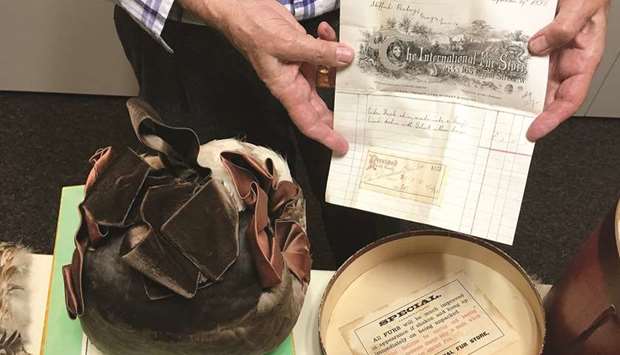One used to sew kilts for his teddy bears following patterns from fashion magazines as an 8-year-old in the 1950s; the other began collecting pipe organs as a teenager in 1968.
It was clear from the start that Martin Kamer and Wolfgang Ruf were not destined for normal 9-to-5 office jobs.
The Swiss and the German both pursued eclectic career paths that eventually led them to start collecting historical clothing. They first encountered one another as rivals on the auction circuit.
Then, 20 years ago, they started working together. They have since assembled one of the world’s largest private collections of clothes and textiles – and now, they’re looking for a new home for it.
Kamer, 75, and Ruf, 69, want it to go to a museum. “We’ve spoken to interested parties in Switzerland, China and elsewhere,” says Ruf.
The materials and clothes, currently in storage in Switzerland, present a seamless – no pun intended – timeline of fashions between 1710 and 1920.
They include more than 600 outfits for men, women and children as well as 800 accessories like hats, shoes, bras and corsets, as well as examples of more than 1,300 textiles dating from between 1430 and 2010.
“This collection can compete with the best in the world: with the Metropolitan Museum for Art in New York, with Los Angeles County Museum of Art, with the Kyoto Costume Institute, or the Victoria and Albert Museum in London,” says Ruf, who lives in the town of Beckenried on the shores of Lake Lucerne in Switzerland.
Christie’s auction house has called it “incomparable.”
It’s hard to find historical clothing at auctions these days. Some pieces can easily cost 200,000 euros (234,000 dollars). “This is definitely the last big collection. There’s nothing left on the market,” says Kamer.
The collection includes a gold brocade dress from around 1793 that belonged to Mary Watson-Wentworth, the wife of British prime minister Charles Watson-Wentworth, with a plunging neckline and a train woven with gold.
There’s also an embroidered suit dating from 1780, which once belonged to a German aristocrat, with a waistcoat, stand-up collar and silk knickerbockers. The jacket has turned wooden buttons covered with hand-embroidered silk.
It’s not easy to find old clothing in good condition – not least because of the lack of toilet facilities back then.
The pair have also avoided clothing with sweat stains.
As dyes weren’t colour-fast back then, clothes couldn’t necessarily be washed and many were only worn a couple of times.
“Fancy dress balls were the worst enemy of historical clothing,” says Kamer. People got down their grandma’s old dresses from the attic and took to them with scissors in order to create snazzy new outfits, he says.
One of the oldest items in the collection is a piece of late Gothic silk velvet from around 1480. It may have originally been created as a wall decoration and survived because it was later used as an altar hanging.
Another highlight is a fabric featuring a circus-themed design by Andy Warhol.
“There were times when Warhol still had to make money,” says Ruf. “And then he designed fabric patterns.”
Kamer, following his passion for fashion, became a stage and costume designer and worked all over the world.
“I first started buying old clothing for fun,” he says. But it eventually became an all-consuming passion. “At the beginning you’re the master of your collection, and at some point the collection becomes your master.”
Despite his early passion for organs, Ruf began his career at his parents’ furniture business.
It was a friend who suggested to him that trading in old clothing could be a lucrative business. Ruf boned up on textiles, founded a gallery and began collecting.
Their pleasure is obvious as they fetch their favourite pieces out of storage to show them off.
There’s also a small boy’s dressing gown from around 1710, and a ladies’ cycling outfit from 1890, with a skirt that’s actually trousers.
The Wentworth dress holds a particularly pleasant memory for Kamer: he bought it in the 1990s at auction in London, where the expert had dismissed it as a costume. But Kamer recognised its real worth and bought it for a bargain price.
Ruf carefully strokes a piece of Renaissance-era velvet with gold brocade dating from 1530, 100 by 80 centimetres in size. Under a magnifying glass, the piece really comes to life: you can see the silk threads bound with finest gold leaf.
It’s impossible to know how many thousands of hours of work were needed to make it.
Over the years, Kamer and Ruf have sold a lot to museums. Around two thirds of the Kyoto Costume Institute’s collection came from them, they say.
Other pieces have gone to Boston, Los Angeles, Berlin, Hamburg, Cologne, Karlsruhe, Munich and Stuttgart – in order to make room for new purchases.
Now, they want to sell their entire collection. But neither plans to stop collecting – Ruf has now reverted to his original passion for instruments, and Kamer is interested in fashion photography. – DPA

ANTIQUE: This muff u2013 complete with bill u2013 is one of the hundreds of items and outfits that make up the Kamer/Ruf collection.


